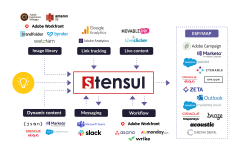It’s Time to Break Down the Gate
- Written by Andrew Gaffney
- Published in Blog

Editor’s note: As part of a special arrangement, the article below has been syndicated from the Content4Demand blog.
G3 Communications has been publishing Demand Gen Report for more than eight years, and from the first day there has always been debate about whether or not marketers should require buyers to fill out a form in order to access content.
This discussion was raised again during David Meerman Scott’s keynote presentation at last month’s Content2Conversion Conference in Arizona. To highlight the bigger potential impact of openly sharing content, the New Rules of Marketing & PR author pointed to none other than The Grateful Dead.
This example may seem like a stretch for a marketing executive on the hook for driving leads. For marketers, content offers are the currency that drives their campaigns, so making assets available without filling out a single field sounds ridiculous.
But Scott did share real-world B2B examples where removing the gate is having significant payoffs, such as MailerMailer, which saw 20x to 50x more downloads once it stopped gating its content.
Scott’s theory is also supported by several data points that came out of our 2016 Content Preferences Study, including:
- 93% of buyers recommend that brands make content easier to access by using shorter forms.
- Content is increasingly becoming viral, with 85% of respondents saying they share content via LinkedIn occasionally or frequently; and 78% say they get more of their content through social networks or peer recommendations.
- A whopping 82% of respondents say they access business-related content on smartphones, and 56% saying they do the same on tablets. But the fact is that mobile devices aren’t ideal screens for filling out forms and downloading content for later viewing.
These new realities present a compelling case that encourages marketers to think through the traditional exchange that takes place between a brand and a prospective buyer. Marketers are increasingly accountable to show results and gather intelligence on their buyers, but they need to find new tools and platforms to gather these insights. The reality is they need to become less dependent on landing pages that require buyers to fill out 10 fields of information to access an asset.
As we established earlier, content is currency and there should be some value placed on the assets brands are creating, especially high-value assets that include proprietary research or original data. In fact, the 2016 Preferences Study validated that buyers expect and are willing to fill out forms in order to access high-value content. Here are some specific variances where executives are willing to pass through a “gate”:
- 79% said they are willing to register for a white paper;
- 77% for webinars;
- 63% will register for E-books; and
- 51% will register for case studies.
Conversely, while interactive content is growing in popularity, the expectation is that these assets should be ungated, with only 31% expecting to register for ROI calculators, 37% for infographics and 23% for videos and motion graphics.
The solution for dealing with this perfect storm for many B2B marketers is a hybrid approach, where high-value assets such as E-books and white papers remain gated, while short-form derivative pieces are immediately available to access and share.
We encourage you to access a copy of the Content Preferences Study, and see how it can help your strategy about whether to gate or ungate specific assets. After you look through the research, we want to hear from you: Has your business taken a new approach to content gating? Are you considering taking a different approach? Share your thoughts in the comments section below!
Related items
-
 Stensul Marketing Creation Platform Seeks To Streamline Asset Collaboration & Creation
Stensul Marketing Creation Platform Seeks To Streamline Asset Collaboration & Creation
-
 #B2BMX Day 3 Recap: Unraveling The Marketer’s Paradox To Enter The B2B Content Renaissance
#B2BMX Day 3 Recap: Unraveling The Marketer’s Paradox To Enter The B2B Content Renaissance
-
 The Intersection Of AI & ABM: Transforming B2B Content Syndication
The Intersection Of AI & ABM: Transforming B2B Content Syndication
-
 3 Boogeyman Strategies B2B Practitioners Must Leave Behind In 2023
3 Boogeyman Strategies B2B Practitioners Must Leave Behind In 2023
-
 Responsive Extends AI Capabilities Within Strategic Response Management Platform
Responsive Extends AI Capabilities Within Strategic Response Management Platform



